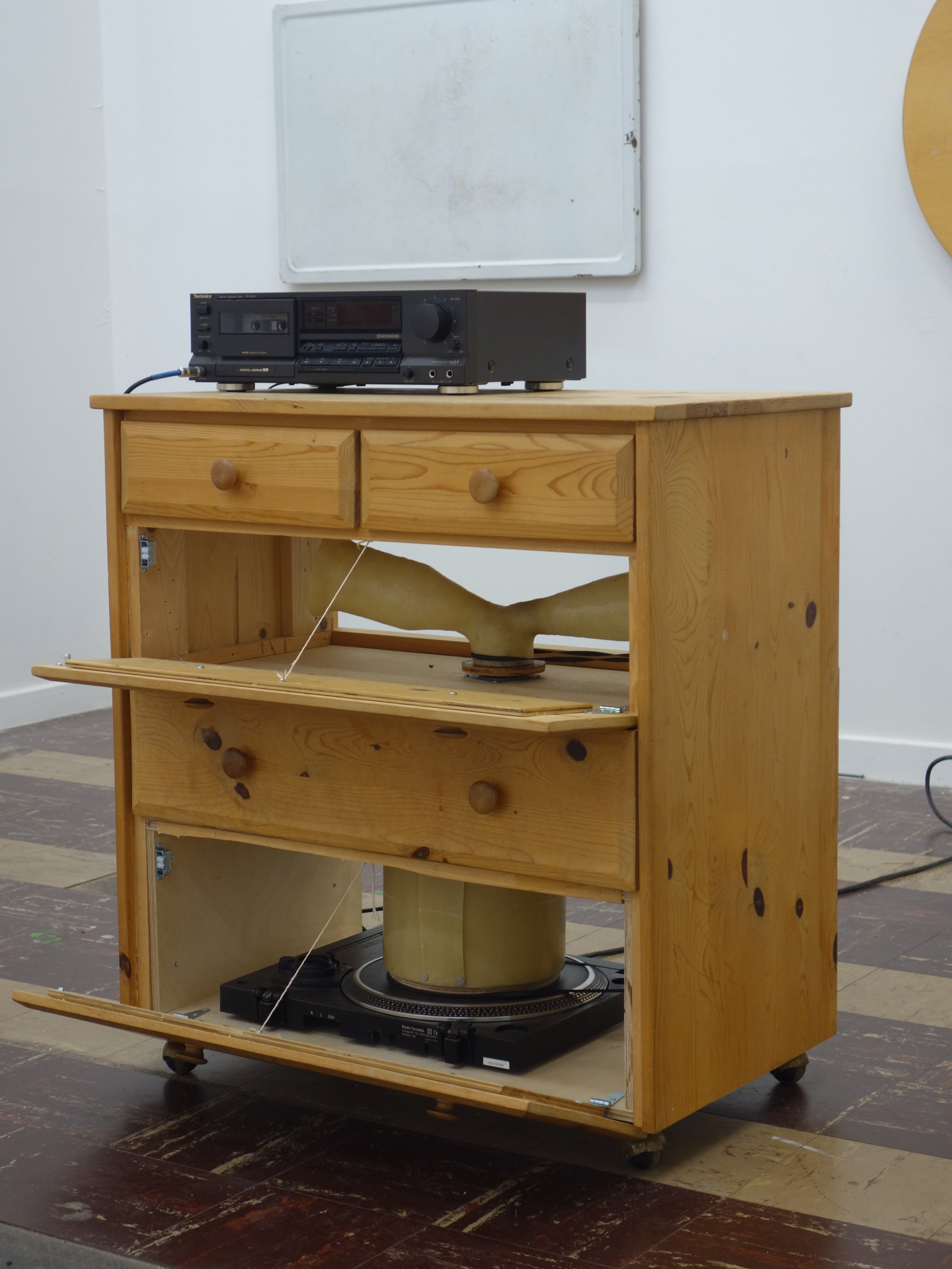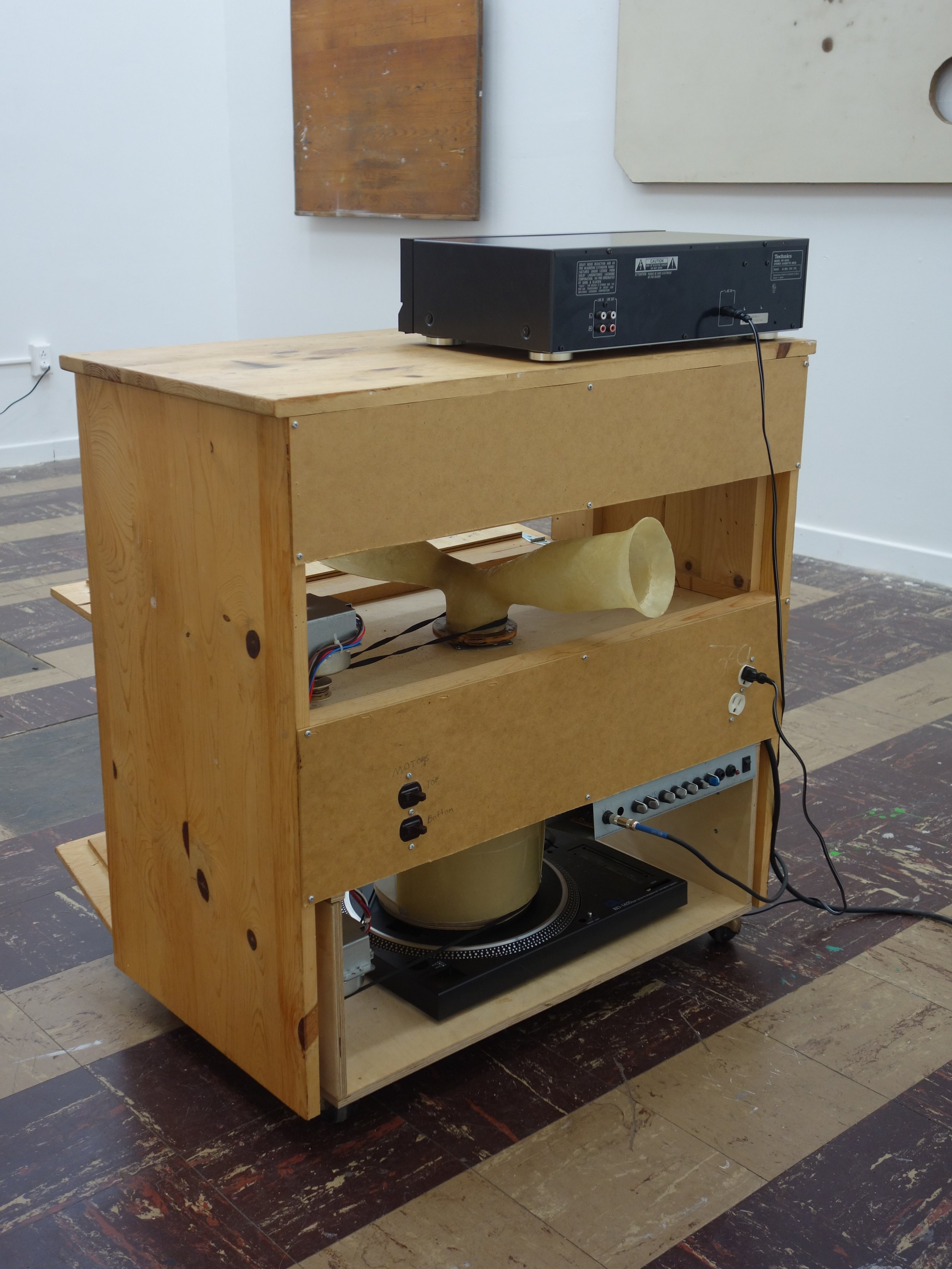Leslie (2023)
Installation from Flashlights
Leslie speaker made out of my Dad’s old dresser and turntable, a guitar amplifier, fan motors, and fiberglass.
During gallery hours it played a tape of his vocal reel from when he recorded advertising jingles to make money as a musician.
At the end of the show’s run, we had a concert inside the gallery, inviting 5 different musicians to demonstrate the sound of the Leslie by playing through it.
Dad showing his Leslie to me, Jan 2022
via wikipedia
My dad had a Leslie speaker he used when he played organ. It is huge older model wood cabinet, a beautiful thing, originally designed to fit inside a church. He explained to me that the Leslie was invented shortly after the electric organ to simulate the sound of church pipe organs, and they were originally marketed and sold to churches. My dad’s came from a church. He would mainly use the larger wooden Leslie when we had parties with music at our house. It was a thing of contention- he used it so infrequently but it took up so much space in storage. He never wanted to give it up though.
After my Dad passed away we started to clear out some of his old stuff. My mom wanted to use his closet, so we took out his big dresser.
I didn’t want to throw it out, but I had no need for it as a dresser. At the time, I was just beginning to conceive of making my own Leslie speaker, and I decided it could be a useful enclosure for that. First I would cut it in half…
I began by making the subwoofer sound deflector drum. I used fiberglass leftovers from the lamps I make.
I endeavored to make it without buying any new materials. To solve the challenge of rotating the drum stably and quietly, I used my Dad’s old broken turntable. I had never worked with motors in a project before. I experimented with using an old out-of-commission drill press as the motor for the drum, since it had an adjustable speed and an adjustable height.
I liked the drill press visually, but it was too loud and the motor wasn’t designed for that kind of sustained stress. I scrapped that idea eventually and convinced my mom to let me disassemble some old fans we had to salvage their motors.
I found a DIY Leslie YouTube video [by Scott Beyer] that provided inspiration and practical guidance for the build. He used soda bottles for his horns. I used two different sparkling water bottles to as molds for the fiberglass horns, and then conjoined them. I learned that in the original Leslie, the sound only comes out of one horn, and the other is simply there as a counterweight. The sound only comes out of the horn with the flared out end, the other horn is plugged up with wood.
I mounted the horn to a lazy Susan bearing, though this is the noisiest part of the whole thing. I’m planning on replacing it with a bearing.
One thing I did buy for the build was a cheap guitar amp from an estate sale that weekend. I took it apart to use as the speaker unit. I used a crossover board I had from a scrapped speaker and wired an additional speaker for the higher frequencies for the horns.
My friend Harlan came over that day and played through it, which was my first time hearing it activated. It sounded great to me.
I reassembled it with the drawer doors, so it would look like a normal dresser from the front.
In the Leslie’s “activated” state, the drawer doors open on hinges to let the sound come out of both sides.
I was going through my dad’s old cassette tapes in the attic and found one that is his old vocal demo. He made it during a period of his life, right before he met my mom, when he supported himself as a musician by recording jingles for commercials. He realized there was good money doing reggae jingles for summertime beer commercials, for which he faked a Jamaican accent. (I never knew that he did this until a few years ago, when I was watching the Whit Stillman movie “Barcelona” and my mom told me that my dad recorded part of the soundtrack- a Caribbean themed Limbo song for a scene when they are doing the limbo at a party. He’s faking a Jamaican accent. It doesn’t sound anything like him.) By the time I was born, my dad was making enough money as a touring musician that he didn’t have to do jingles, or fake an accent, so they were never mentioned. Doing jingles for a few years got him to a place of enough stability that he could continue playing music for the rest of his life and support a family. I owe a lot to those jingles.
The Leslie was activated by whomever was sitting at the gallery that day. When a visitor was in the gallery, the sitter would switch on the motors and hit play on the cassette deck and the vocal reel tape would play for about 3 minutes, then they’d switch the whole thing off.
The night of performances through the Leslie was extremely gratifying. It was my first time organizing musicians together for an event. It was the first time any of the musicians had performed solo. Everyone seemed to get a lot out of it. It was amazing to hear the Leslie activated through different instruments, since the recorded tape is too sonically complex to really hear the effects of the Leslie.
I brought the Leslie back home to LA after the closing of the show, and reunited it with the other half of the dresser. I needed to get rid of the other half, and it was still totally functional as a dresser. My friend mentioned he had been looking for a small dresser on craigslist, and I told him he should just take mine.
Since I cut the dresser in half, the bottom half had no top, so I had to make a new one out of boards I had (right).
There was also a broken leg on the dresser that needed to be fixed before my friend could use it.
I came up with this funny fix with an old cane I had lying around.
And finally, I replaced the white porcelain knobs with wooden ones that matched the original.






























